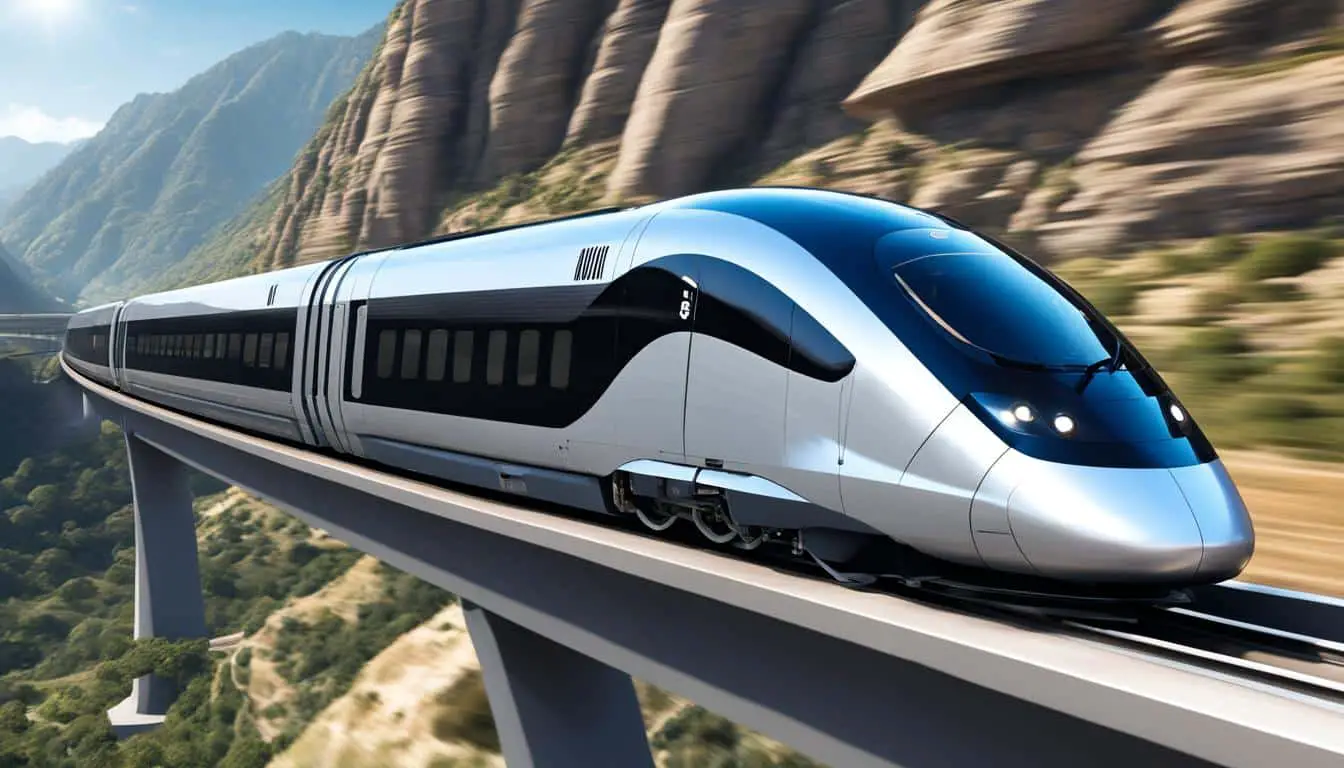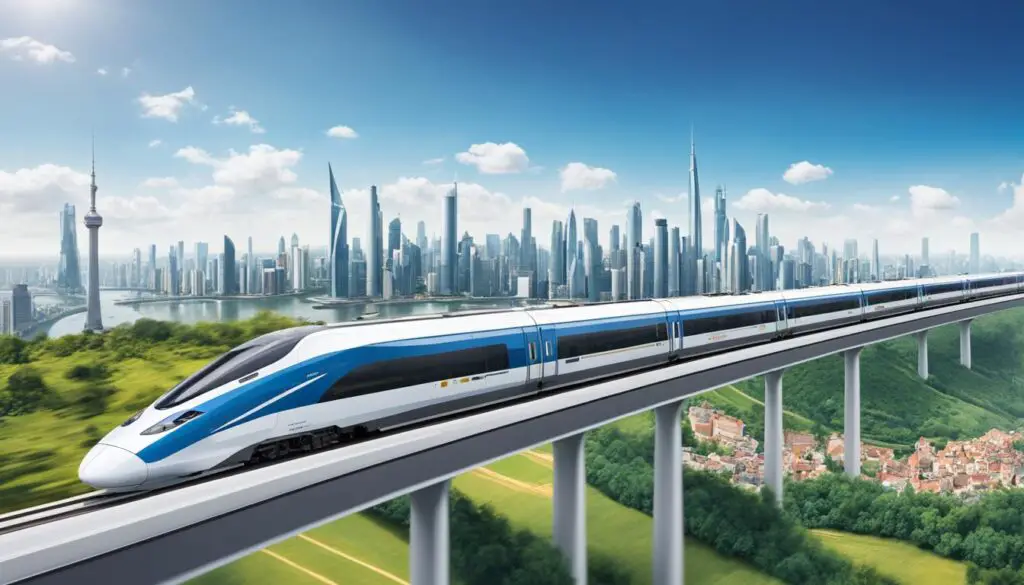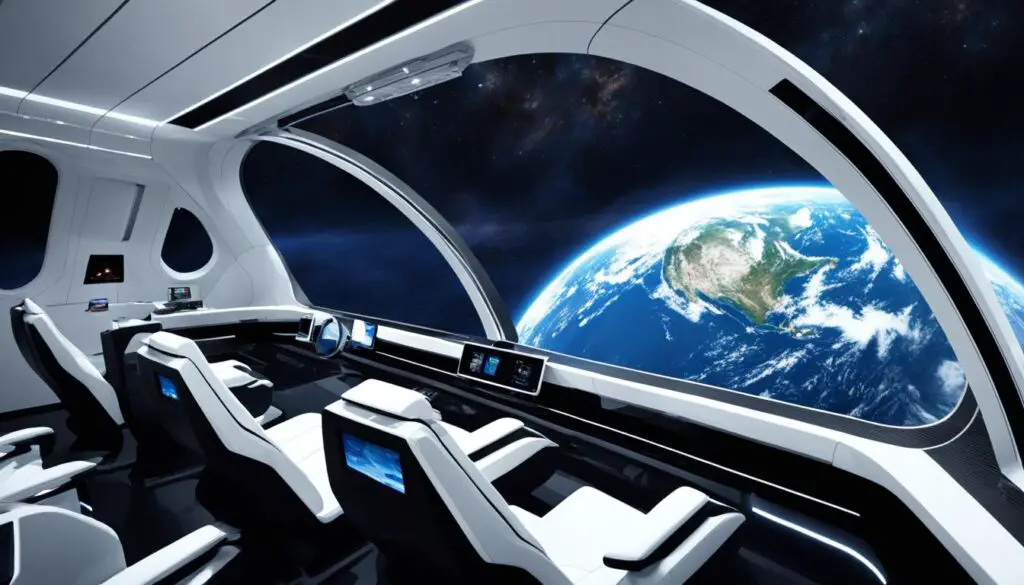
High-Speed Train Technology: The Next Frontier in Travel
High-speed train technology is driving a new era of efficient and advanced rail travel. From cutting-edge innovations to the potential for future developments, high-speed trains are revolutionizing the way we journey from one destination to another. With their ability to reach incredible speeds and reduce travel times, these trains offer an exciting and sustainable mode of transportation for passengers around the world.
Key Takeaways:
- High-speed train technology is transforming the travel industry with its innovative advancements.
- These trains enable efficient rail travel, reducing travel times for passengers.
- Advanced features and technologies enhance the overall passenger experience.
- High-speed trains offer a more sustainable mode of transportation compared to other options.
- The future of high-speed train technology holds immense potential for further innovations and advancements.
The Evolution of High-Speed Trains
High-speed train technology has come a long way since its inception. From its humble beginnings, such as the Viking program in the late 1970s, to the present-day endeavors in Mars exploration, the evolution of high-speed trains has been intertwined with the quest to understand our neighboring planet.
The Viking program marked a significant milestone in Mars exploration. Launched by NASA, the Viking 1 and Viking 2 spacecraft were the first to land on Mars, capturing the imagination and curiosity of people worldwide. These missions paved the way for subsequent rovers like Curiosity and Perseverance, which have played a pivotal role in gathering valuable insights about the Martian surface and its potential for colonization.
“The exploration of Mars has pushed the boundaries of space exploration and captured the attention of the scientific community and the general public alike.” – said by a leading NASA scientist.
Private sector initiatives, such as SpaceX’s Starship project, have brought the possibility of manned missions to Mars closer than ever before. With ambitions to establish a permanent human presence on the red planet, these initiatives demonstrate the growing interest and investment in Mars colonization.
However, the advancements in Mars exploration have also sparked discussions about the potential for space tourism. As we delve deeper into the mysteries of the universe, the idea of venturing beyond our planet becomes an attainable reality. Space tourism presents an opportunity to experience the wonders of space firsthand, ushering in a new era of exploration and adventure.
Mars Missions Comparison
| Mission | Launch Date | Duration |
|---|---|---|
| Viking 1 | August 20, 1975 | 6 years |
| Viking 2 | September 9, 1975 | 6 years |
| Curiosity | November 26, 2011 | Ongoing |
| Perseverance | July 30, 2020 | Ongoing |
The future holds even more exciting possibilities for high-speed train technology and its connection to Mars exploration. As we continue to unravel the mysteries of the universe and strive for interplanetary travel, the evolution of high-speed trains will play a crucial role in shaping the future of transportation.
Innovations in High-Speed Train Technology
One of the most groundbreaking innovations in high-speed train technology is the Mars Helicopter, also known as Ingenuity. Ingenuity—sent alongside NASA’s Perseverance rover—successfully demonstrated controlled flight in the Martian atmosphere, paving the way for future aerial exploration. This technological breakthrough will undoubtedly influence the design of future vehicles for Mars exploration, making them more versatile and capable of navigating diverse terrains.
| Advancements | Impact |
|---|---|
| Aerial exploration capability | Unprecedented access to remote and challenging areas on Mars |
| Enhanced maneuverability | Efficient traversal of varying terrains |
| Improved data collection | In-depth analysis of Martian features and geology |
| Increased operational efficiency | Optimized resource utilization during missions |
Ingenuity has proven that aerial exploration on Mars is not only possible but also invaluable for scientific research and future colonization efforts. With its ability to cover extensive areas and reach inaccessible regions, aerial vehicles like Ingenuity are set to revolutionize the way we conduct exploration and gather crucial data on Mars. This innovation opens up new possibilities for discovering hidden Martian secrets and understanding the planet’s history and potential for sustaining life.
Collaborations and the Future of High-Speed Trains
The exploration of Mars is a monumental undertaking, requiring the collective efforts of the international space community. Through international cooperation and collaboration, space agencies around the world are pooling their resources, knowledge, and expertise to push the boundaries of Mars exploration.
The Mars scientific community plays a crucial role in advancing our understanding of the Red Planet. Scientists, researchers, and engineers from various countries come together to share data, insights, and technologies, enabling more efficient and effective exploration.
Advancing Manned Missions
The future of high-speed train technology in space extends beyond robotic missions. Manned missions to Mars are on the horizon, with plans to establish a permanent human presence on the planet. This ambitious endeavor requires meticulous planning, coordination, and international collaboration.
Space agencies are working together to develop cutting-edge spacecraft and habitats capable of withstanding the harsh Martian environment. By leveraging the expertise of different nations, these missions can benefit from diverse perspectives, experiences, and technological advancements.
Sample Collection and Return
A key objective of future Mars missions is to collect and analyze samples from the planet’s surface. Robotic missions equipped with advanced tools and instruments will be deployed to gather valuable data and potential evidence of past water presence and signs of extraterrestrial life.
International cooperation allows for the sharing of sample collection techniques, expertise, and resources. By pooling together the efforts of multiple space agencies, a broader range of samples can be collected and analyzed, maximizing the scientific discoveries and insights gained from Mars exploration.
The Benefits of Collaboration
International cooperation in Mars exploration brings numerous benefits to the scientific community and humanity as a whole. By collaborating and sharing resources, space agencies can minimize duplication of efforts and optimize the utilization of limited resources.
Collaboration also fosters knowledge exchange, enabling researchers to learn from one another’s experiences and discoveries. This collective effort accelerates progress and leads to more breakthroughs in our understanding of Mars and its potential for supporting life.
Furthermore, international cooperation sets a positive precedent for future space exploration endeavors beyond Mars. As humanity sets its sights on new frontiers, collaboration will play a vital role in addressing complex challenges and maximizing our scientific achievements.
“International collaboration is essential for the success and sustainability of Mars exploration. By working together, we can unlock the mysteries of the Red Planet and pave the way for future space discoveries.”
The Future of Collaborative Mars Exploration
As the global space community continues to collaborate and push the boundaries of Mars exploration, high-speed train technology will play a significant role in supporting these missions. The efficient transportation of astronauts, equipment, and supplies will be crucial for the success of manned missions and sample return efforts.
| Benefits of International Cooperation in Mars Exploration | Collaborative Efforts |
|---|---|
| Shared resources and expertise | Space agencies pooling their resources, knowledge, and technologies |
| Cost optimization | Minimization of duplication of efforts and optimization of limited resources |
| Accelerated scientific progress | Knowledge exchange, learning from each other’s experiences and discoveries |
| Maximized sample collection | Pooling together efforts to extract a broader range of samples from Mars |

Advancements in Space Tourism and High-Speed Trains
High-speed train technology is not limited to planetary exploration. The rise of space tourism has opened up a new frontier for adventure. Visionary entrepreneurs like Elon Musk, Jeff Bezos, and Richard Branson are venturing into this field, aiming to make space travel accessible to civilians. Companies like Virgin Galactic have pioneered suborbital flights, providing individuals with the opportunity to experience weightlessness and witness the curvature of the Earth.
Amidst these developments, advancements in technology are paving the way for orbital space tourism, allowing civilians to orbit the Earth for an extended period. The dream of experiencing the vastness of space firsthand is becoming a reality, thanks to the progress in commercial space travel. SpaceX’s ambitious Starship project aims to take space tourism beyond Earth’s orbit, enabling journeys around the Moon and even potential trips to Mars.
Commercial Space Travel: Opening Up Opportunities for All
Space tourism offers a unique perspective that goes beyond traditional travel experiences. The opportunity to see our planet from the vantage point of suborbital flights or orbiting in space is an experience like no other. Moreover, the growth of space tourism has the potential to inspire new innovations, create jobs, and drive scientific advancements.
“Space tourism has the potential to transform the way we perceive and explore our universe. It opens a window to the unknown, igniting our curiosity and pushing the boundaries of what we thought was possible.” – Elon Musk
The commercial space travel industry is rapidly evolving, with various companies investing in the development of spacecraft and infrastructure required for safe and enjoyable space travel. As technology continues to advance, space tourism could become an accessible and sought-after adventure for individuals from all walks of life.

The Future of Space Exploration and High-Speed Trains
The synergy between space tourism and high-speed train technology holds exciting possibilities for the future. As the infrastructure for suborbital and orbital space tourism expands, high-speed trains can contribute to seamless transportation between cities and spaceports. By integrating various modes of transport and ensuring efficient connectivity, travelers can embark on an unforgettable journey from their hometowns to the stars above.
In Summary
Advancements in space tourism and high-speed trains are transforming the way we explore and travel. From suborbital flights to orbital space tourism, these innovations offer unprecedented opportunities for individuals to witness the wonders of space and broaden our understanding of the universe. As technology continues to progress, space tourism and high-speed trains will unlock new frontiers and shape the future of travel.
Conclusion
The future of high-speed train technology is incredibly promising, with numerous innovations revolutionizing the way we travel. From advancements in planetary exploration to the rise of space tourism, the boundaries of travel are expanding like never before. As these advancements continue to emerge, high-speed trains are poised to play a significant role in transforming transportation.
With their ability to provide efficient and advanced rail options, high-speed trains offer passengers a convenient and time-saving mode of travel. The advancements in technology have allowed for faster speeds, smoother rides, and improved connectivity. Passengers can now reach their destinations quickly and comfortably, experiencing a whole new level of convenience.
Furthermore, the world of high-speed trains is continually evolving, birthing exciting innovations and potential future developments. These innovations aim to enhance travel experiences, focusing on safety, sustainability, and passenger satisfaction. From cutting-edge train designs to advanced propulsion systems, high-speed trains are at the forefront of transportation innovation.
In conclusion, high-speed train technology is transforming the way we travel, offering efficient, advanced, and environmentally-friendly options for passengers. As these technologies continue to progress, the future of high-speed trains will undoubtedly shape the future of transportation, providing a convenient and sustainable means of travel for people around the world.
FAQ
What is high-speed train technology?
High-speed train technology refers to the advancements and innovations that have enabled trains to travel at significantly faster speeds than traditional trains. It involves the development of specialized infrastructure, train designs, and propulsion systems to achieve efficient and rapid rail travel.
How has the Viking program contributed to high-speed train technology?
The Viking program was not directly related to high-speed train technology. It was a space exploration program launched in the late 1970s by NASA to explore Mars. However, the advancements made in space exploration, including the development of sophisticated engineering solutions for planetary missions, have indirectly influenced the evolution of high-speed train technology.
What role does the Mars Helicopter play in high-speed train technology?
The Mars Helicopter, also known as Ingenuity, is not directly related to high-speed train technology. It is a small robotic helicopter that was sent to Mars alongside NASA’s Perseverance rover to demonstrate controlled flight in the Martian atmosphere. However, the technology and engineering solutions used in the Mars Helicopter can potentially inform the design of future vehicles for high-speed train travel.
How does international cooperation impact the future of high-speed trains?
International cooperation plays a crucial role in the future of high-speed trains. Collaboration between space agencies and the Mars scientific community allows for the sharing of resources, knowledge, and expertise. This collaboration can lead to more efficient exploration, advancements in technology, and the development of new solutions for high-speed train projects, including manned missions and sample collection.
What is the relationship between space tourism and high-speed train technology?
Space tourism and high-speed train technology are not directly related. However, both fields share a common goal of pushing the boundaries of travel. The advancements in technology and infrastructure required for space tourism can indirectly influence the development of high-speed trains, making them more efficient, comfortable, and accessible for passengers.
How will high-speed train technology shape the future of travel?
High-speed train technology has the potential to revolutionize the way we travel by offering efficient and advanced rail options for passengers. With ongoing innovations and advancements, high-speed trains will provide faster, more comfortable, and environmentally friendly transportation solutions, expanding the boundaries of travel and shaping the future of transportation.
Source Links
- https://apparelresources.com/business-news/retail/n-brown-group-hires-new-director-supply-chain/
- https://apparelresources.com/business-news/trade/suez-panama-jams-perfect-storm-fast-fashion-says-delivery-specialist/
- https://www.bulbapp.io/p/fee49309-1c6f-4947-ad8d-9802e65c83aa/beyond-earth-exploring-space-colonization-and-extraterrestrial-life
